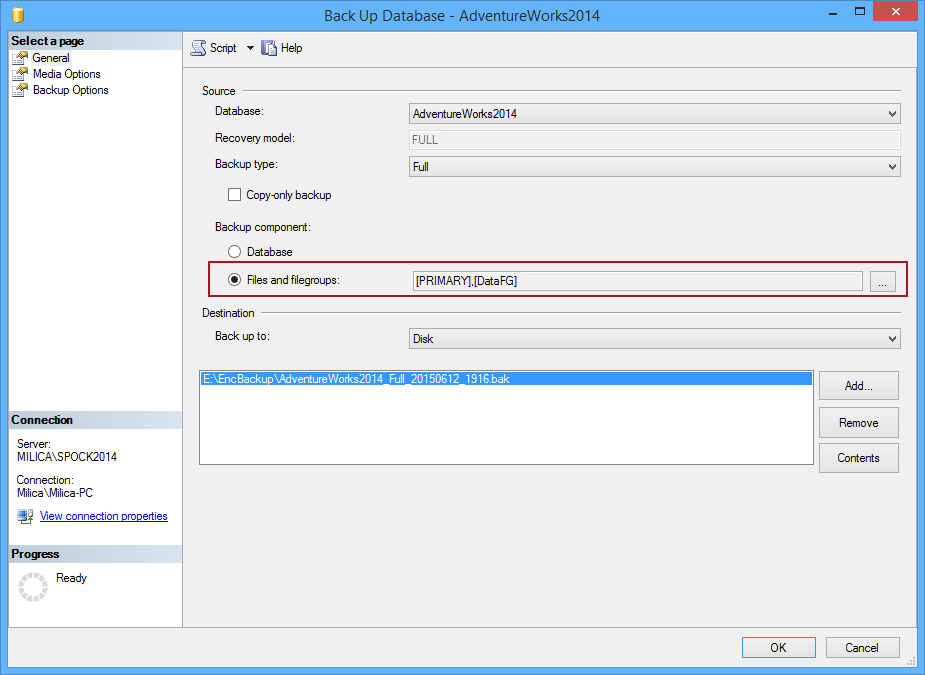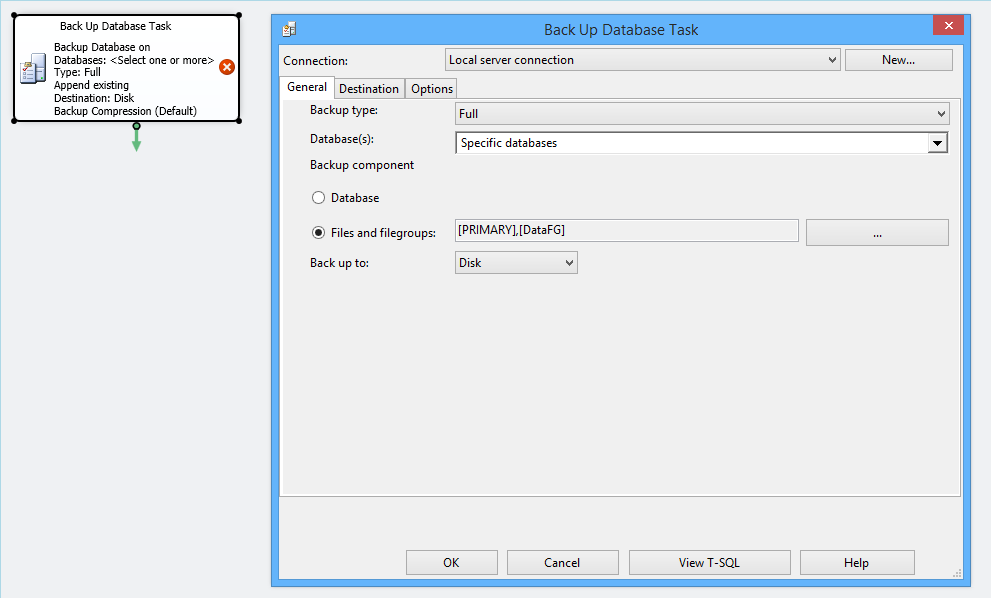This article explains how to create filegroups and move indexes into a different filegroup, and how to backup a database without indexes with the purpose to reduce the amount of data required to perform backups thus reducing backup time and space required.
Why using this approach?
In database development, a database backup is often created for the purposes of backup verification and testing. Backing up a whole database requires both time and space. Also, when implementing log shipping the user has to do a database backup, transfer it over the network and perform a restore it, which is a time-consuming process.
Backing up only data without the indexes would reduce the time and space amount required for a full back up significantly.
How to implement this approach?
To implement this approach the user should create new filegroups and store the data and indexes into separate filegroups.

Every database has one PRIMARY filegroup that contains the primary data file (recommended primary file extension is .mdf ) and all other files that are not placed into other secondary filegroups.
Filegroups can be added either directly from the SQL Server Management Studio or by using the T-SQL scripts.
To create data and index filegroups run the following T-SQL script:
ALTER DATABASE AdventureWorks2014 ADD FILEGROUP IndexesFG GO
To check created filegroups run the following T-SQL script:
USE AdventureWorks2014 SELECT name AS [Filegroups] FROM sys.filegroups WHERE type = 'FG'
Moving indexes into another Filegroup
To find all non – clustered indexes in a database use the following script:
SELECT sys.tables.name AS TableName, sys.indexes.name AS IndexName, sys.indexes.is_primary_key AS PrimaryKey, sys.indexes.type_desc AS IndexType FROM sys.indexes, sys.tables WHERE sys.indexes.object_id = sys.tables.object_id AND sys.indexes.type = 2 ORDER BY TableName
To find all clustered indexes just change the AND sys.indexes.type = 2 value in AND sys.indexes.type = 1
Clustered indexes can/should be on a data filegroup and non-clustered on a separate if you want to separate data and indexes because if a table contains a clustered index, moving the clustered index to a new filegroup also moves the table to the same filegroup.
Other types of indexes are as follows:
3 - XML indexes
4 - Spatial indexes
5 - Clustered columnstore indexes, that applies only to SQL Server 2014 and SQL Server 2016
6 - Non- clustered columnstore indexes, applies to SQL Server 2012, SQL Server 2014, and SQL Server 2016.
7 - Non- clustered hash indexes, applies to SQL Server 2014 and 2016.
We will show an example of moving a non- clustered index to another filegroup, as there is no alternative other than to script the indexes, change the ON clause, drop indexes, and re-run the new script. There are a lot of free scripts available to achieve scripting all indexes and moving them to a specified filegroup and it is out of the scope of this article.
Example:
/* Adds the IndexesFG file to the IndexesFG filegroup */ ALTER DATABASE AdventureWorks2014 ADD FILE ( NAME = TransIndexesFG, FILENAME = 'C:\Program Files\Microsoft SQL Server\MSSQL12.SPOCK2014\MSSQL\DATA\IndexesFG.ndf', SIZE = 5MB, MAXSIZE = 100MB, FILEGROWTH = 5MB ) TO FILEGROUP IndexesFG; GO /* Creates the IX_SpecialOfferProduct_ProductID index on the IndexesFG filegroup and drops the original IX_SpecialOfferProduct_ProductID index */ CREATE NONCLUSTERED INDEX IX_SpecialOfferProduct_ProductID ON Sales.SpecialOfferProduct (ProductID) WITH (DROP_EXISTING = ON) ON IndexesFG; GO
How to back up a database without the index data by using SQL Server Management Studio
SQL Server Management Studio allows backing up specified filegroups as an option in a regular database Backup task. To back up a database without the index data by using SQL Server Management Studio:
- Right click a database and select Tasks -> Backup:
-
In the Back Up Database dialog select the Files and filegroups option and specify a desired filegroup:
-
In the Object Explorer pane, right click the Management node and select the New Maintenance Plan option:
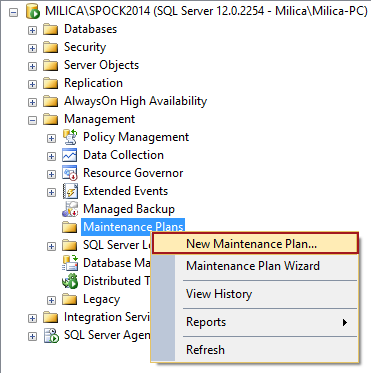
-
In the New Maintenance Plan dialog name a new plan:
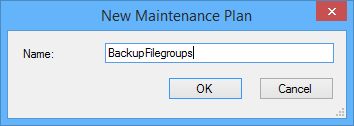
-
From the Maintenance Plan Tasks toolbar select Back Up Task:
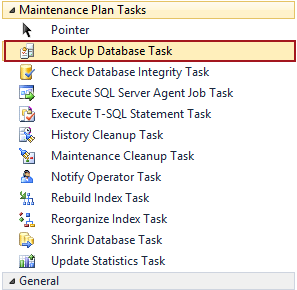
-
Double click on an added task, specify a database, check the Files and filegroups option, and specify the filegroups for back up:
-
To schedule Back Up Database Task use the SQL Server Agent scheduler:
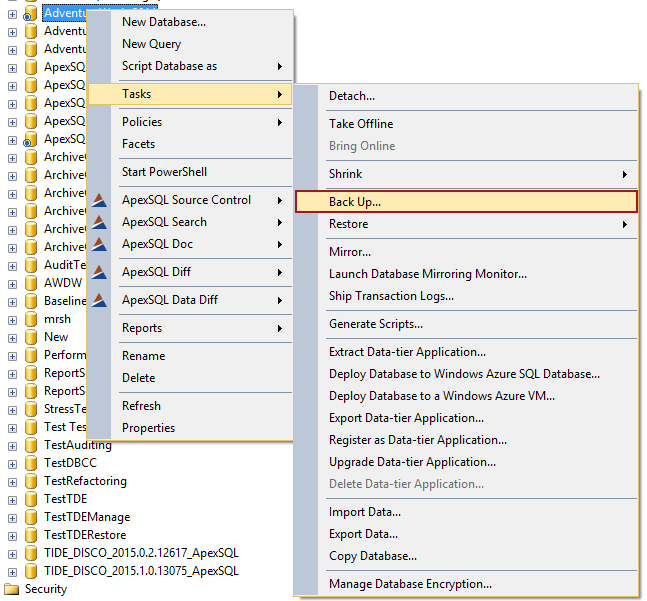
This approach is straight forward, but a downside is that is cannot be scheduled without creating a T-SQL script and scheduling it as a SQL Server Agent job.
How to back up a database without the index data by using Maintenance Plans
Backing up the desired files and filegroups can be achieved by using the Back Up Task.
To back up a database without the index data by using Maintenance Plans:
Although Maintenance Plans offer a scheduling option, the Maintenance Plan Tasks toolbar doesn’t contain a restore task, so having a complete solution would require using Execute T-SQL Statement Task.
July 2, 2015



